2012 VOLKSWAGEN GOLF MK6 tow
[x] Cancel search: towPage 252 of 516

Volkswagen Service Vehicles with Xenon
gas-discharge self-adjust to vehicle load
and do not need manual adjustment.
Special towing considerations
th e t railer has an overrun brake, apply the
br akes
Due to the combined towing weight including
the higher gross vehicle weight, the stopping
tance is longer.
Be fo re drivi ng especially on
The vehicle's center of grav ity and , in turn, the
Weight distribution is especially bad if the is emp ty and the trailer is loaded.
Depending on how steep the is an d the
backwards when you first start moving.
When starting off with a tra iler on a
Depress and hold the brake pedal and depress
and hold the clutch (manu al transmission).
171, Shifting .
Unlock the parking brake a nd gently release it
whi le holding the unlock button. At the same time,
release the brake pedal and
depress the
accelerator and, for manual transmissions , let out
the clutch
you can feel the car moving ward . applicable, follow the instruct ions for the Hold feat ure
Do not release the parking brake lever until the
engine starts to move the vehicle forward. your
vehicle has an automatic tr ansmission , you can
so depress and hold the brake peda l for added
b raking and then Jet up on the brake pedal when
you feel that the to move forward .
Drive ahead slowly.
hicle contro l and serious per sonal injury.
dles and increases the distance it needs to stop safely .
Always adapt your sp ee d and driving to th e heavier loa d and the weight distribution in the vehicle. Tak e road , weather , traffic, and visibility conditions into account as well .
Always avoid sudde n maneuv ers and ha rd braking.
atin g.
som e areas
s p ee d for vehicles towing trailers are
lower than for vehicles without trailers.
Page 253 of 516

mount support .
tory Information and heed the on page 149.
Your vehicle
is not equipped with a trai ler hitch or p reparations for the in stalla tion of a trailer hitch. tf
you must tow a trailer , you must have the
ry electrical wiring and socket together with a Because towing a traile r
pl aces a great dea l of stress on the vehicle, the
sions of the receive r and
ometry and size . T his app lies to both the height of th e above the surface where it attaches
m ount
and m ake sure that th ey meet th e
The drop height ® from the center of the
The distance @from the center of
the
T he
Never izing " trailer hitch on your vehicle . T he vehicle is
not designed for this kind of trailer hitch .
An improperly or unsuitable trailer hitch can cau se the trailer to s eparate from the towing vehicle and result in a major acci-dent with serious personal injuries.
carrier when you are not towing a trailer.
cle was not designed to tow heavier trailers with a receiver larger than the specified ball.
The increased loads can damage the
ment points for the trailer hitch.
Never use an adapter to the size of the trailer hitch receiver from 1 1
/4 inches (32 mm) to 2
weight that your vehicle can tow.
You can use an adapter if require d for the proper ins ta llation of a bicycle rack or o th er similar carrier as long as the maximum weight limits are observed . When using bicyc le rack s or simil a r carri ers, mak e sure th at the rear lights are not blo cked .
use trail er hitches that are approved by the hitch manufacturer for your vehicle and
model.
Page 259 of 516

Storage compartment in the rear center console
Fig. 98
the luggage compartment:
on page 157 .
Storag e compartments in the luggag e compartment
Add itiona l storage compartments are located in the
sides of the luggage compartment. The side
els can be re m ove d by pushing upward in the rec tion of the arrow 99 to make room for er objects in the luggage compartment.
Before driving
on p ag e 157 .
T her e is a storage compartment for stowing
objects 98 in the back of the center conso le.
Pockets in the back rests of the fron t seats .
ment 14 1.
C lothes or other items on the shelf behind the rea r sea t backres t m ay limit visibility, a nd
ca use acci dents a nd seve re person al injuries.
Alw ays ha ng c loth es so th at th ey do not lim it v isibility.
Page 264 of 516
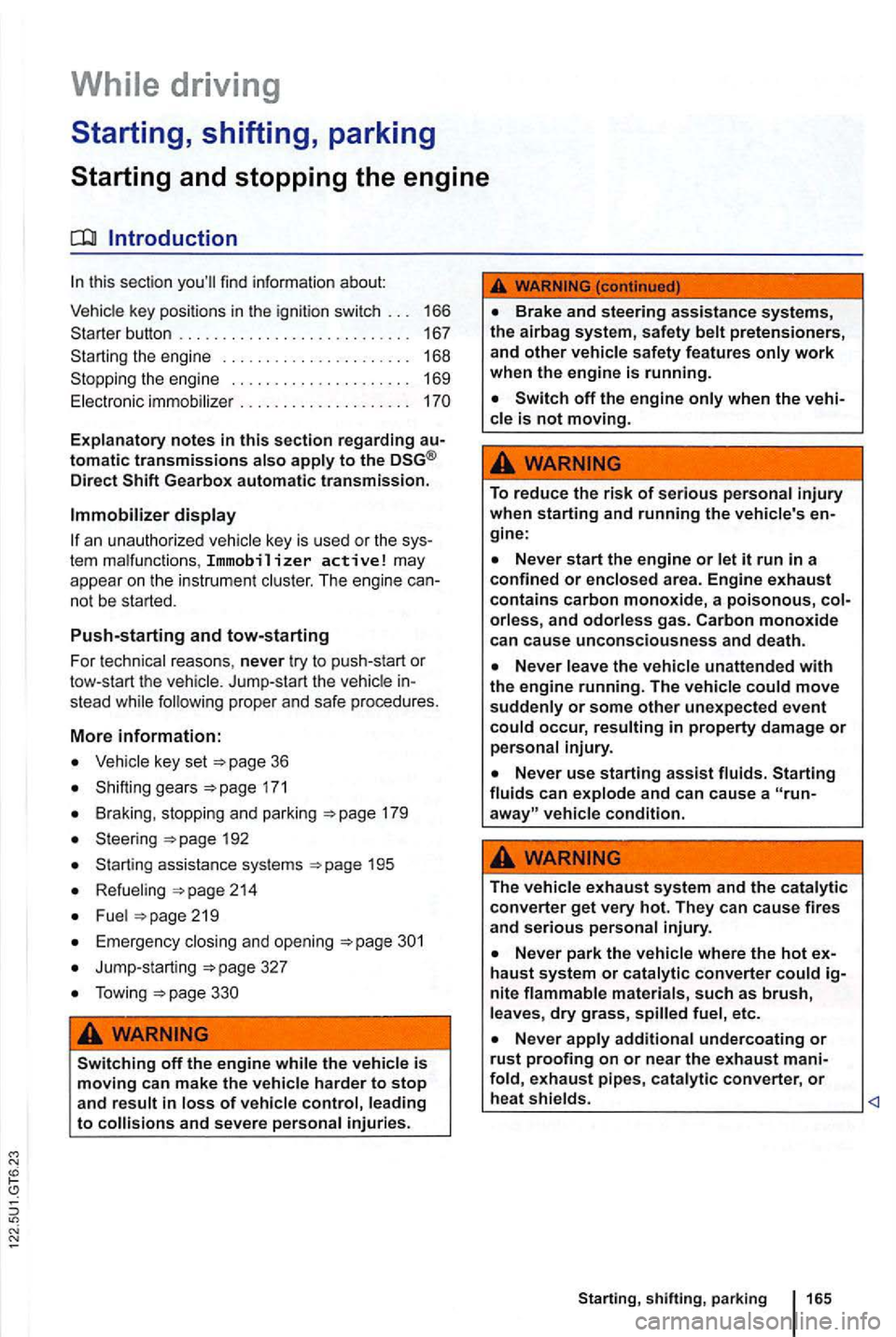
Explanatory notes in this section regarding tomatic transmissions Direct
an unauthorized vehicle key is used or the sys
tem mal functions , Immobilizer active! may
appear on the instrument
stead wh ile following proper and safe procedures.
More information:
Vehicle key set
Shifting gears
Braking , stopp ing and parking =>page 179
Steering 192
Startin g assistance systems
Refueling =>page 214
Emergen cy clo sing and opening
Jump-starting
Towing
off the engine while the vehicle is moving can make the vehicle harder to stop and result in loss of vehicle control, leading to collisions and severe perso nal injurie s.
To reduce the risk of serious personal injury when starting and running the vehicle's gine:
shifting, parking 165
Page 278 of 516
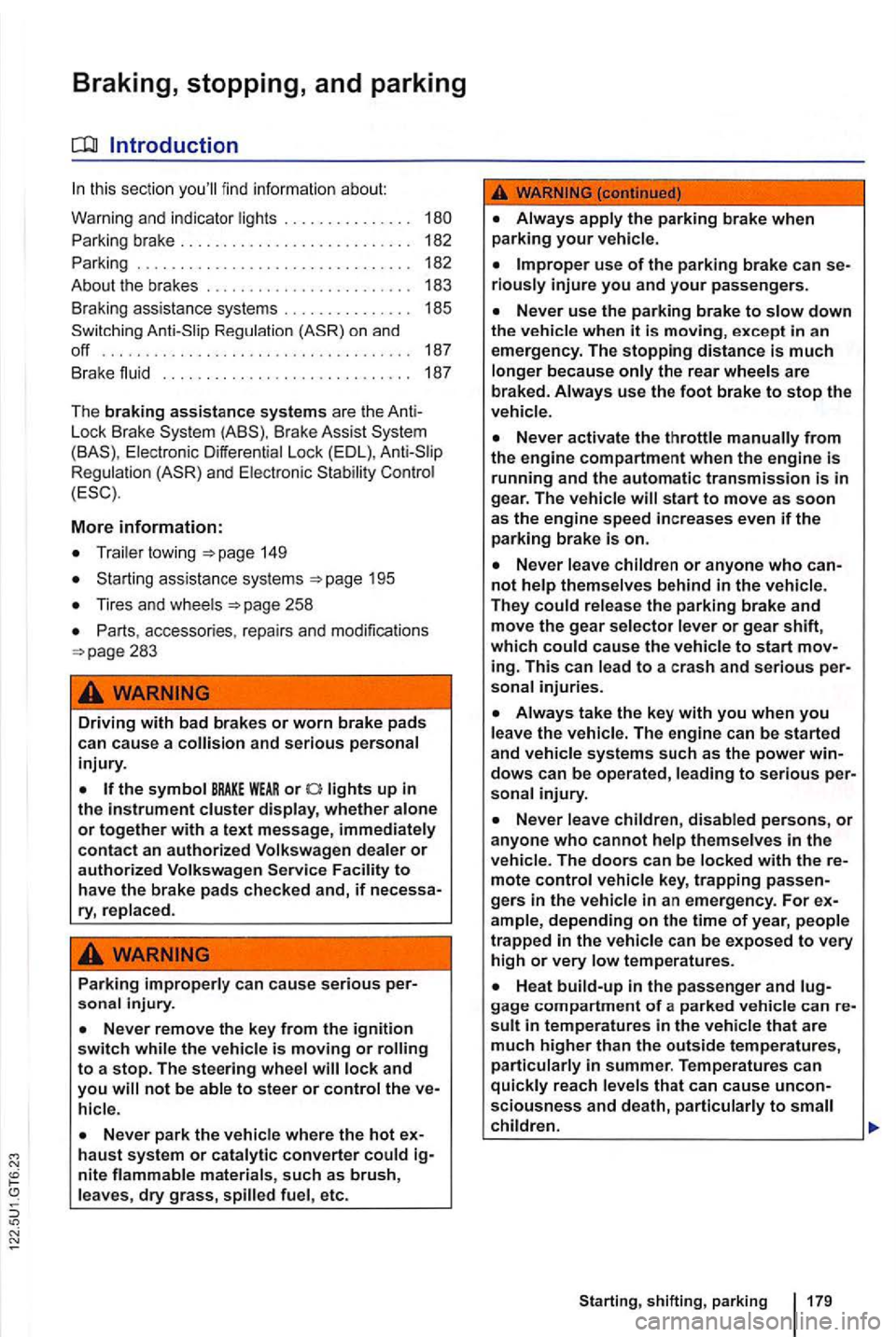
Braking, stopping, and parking
this sectio n
Parking brake . . . . . . . . . . . 182
P arking . . . . . . . . . . . . . .
. . . . . . . . . . . . . . . . . 182
About the brakes . . . . . . . . . . . . . . . . . . . . . . . . 183
Braking assistance systems
Switching
L ock Brake System (ABS) . Br ak e Assist System
(BAS ), Ele ctronic Differential Lock (EDL), R eg ulatio n (ASR) and Electronic C ontrol
(ESC).
More information:
Trai ler towi ng 149
Starting assistance systems 1 95
Tires and whee ls 258
Driving with bad brakes or worn brake pads can cause a and serious personal
injury.
lights up in the instrument cluster display, whether alone or together with a text message, immediately contact an authorized Volkswagen dealer or authorized Facility to have the brake pads checked and, if necessa
ry, replaced .
Parking improperly can cause serious sonal injury.
lock and you
haust system or catalytic converter could
fu el, etc.
riously injure you and your passengers.
sonal injury.
mote control vehicle key, trapping passengers in the vehicle in an emergency. For ample, depending on the time of year, people trapp ed in the vehicle can be exposed to very high or very low temperatures.
children.
Starting, shifting, parking 179
Page 283 of 516
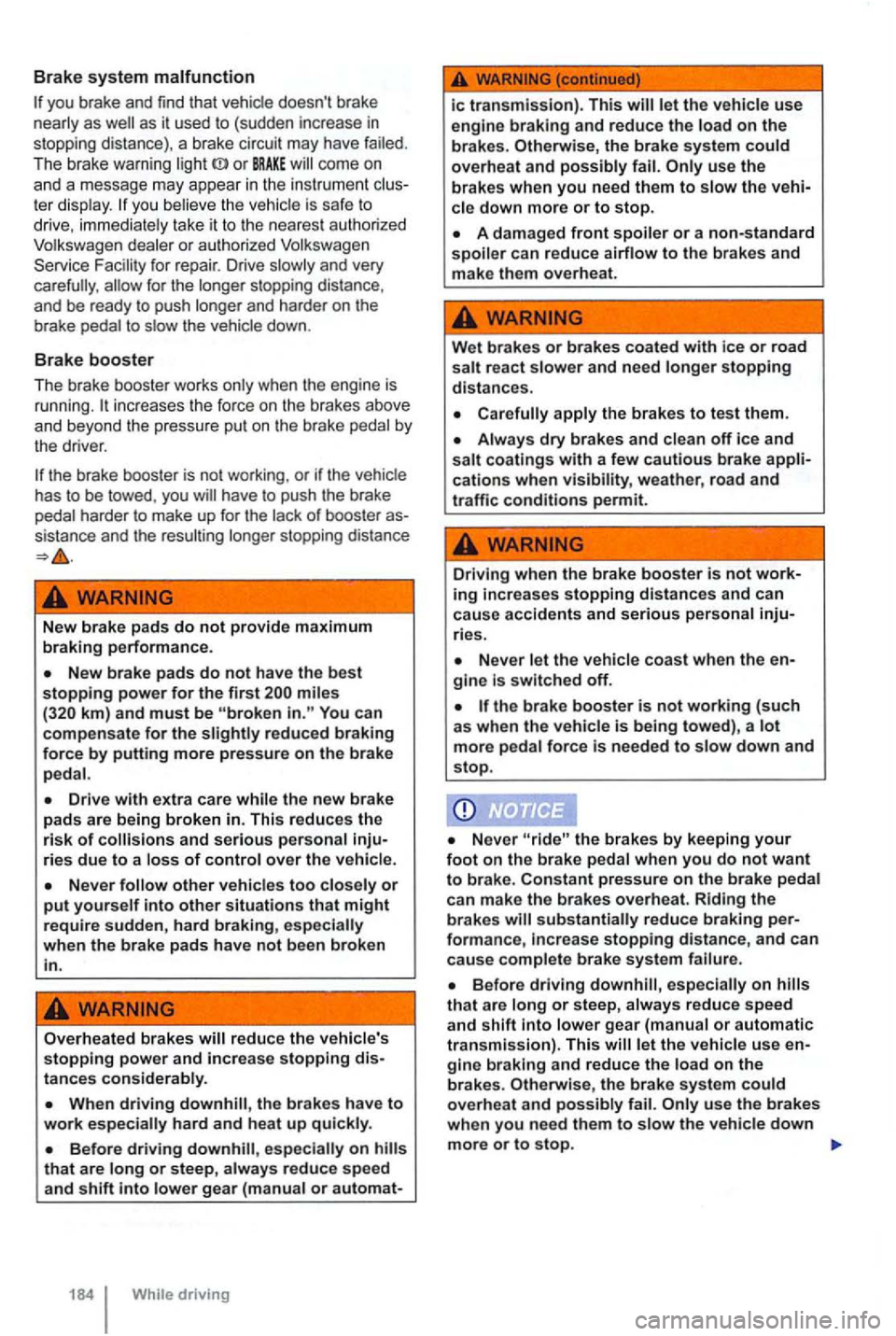
Brake system malfunction
you brake and find that vehicle doesn't brake
nearly as
come on
and a m essage may appear in the instrument ter display. you believe the vehic le is safe to
d rive, immediately take it to the nearest authorized
Volkswagen dealer or authorized Volkswagen
Service
f or repair. Drive slowly and very
carefully , for the longer stopping distance ,
and be ready to push longer and harder on the
brake pedal to slow the vehicle down.
Brake booster
The brake booster works only when the engine is
running . in creases the force on the brakes above
and beyond the pressure put on the brake pedal by
the driver .
New brake pad s do not provide maximum braking performance.
miles You can
compensate for the reduc ed braking force by putting more pressure on the brake
pedal.
other vehicles too closel y or put yourself into other situations that might require sudden, hard braking , especially
when the brake pads have not b ee n broken
in.
Overh eated brakes reduce the vehicle's stopping power and increa se stopping distances considerably.
that are long or s teep, always reduce speed
and shift into lower gear (manual or automat-
184 While driving
ic transmission). This let the vehicle use
engine braking and reduce the load on the brakes. Otherwise, the brake system could overheat and possibly fail.
A damaged front spoiler or a non-standard spoiler can redu ce airflow to th e brakes and make them overheat.
Wet brakes or brakes coated with ice or road
salt react slower and need longer stopping distances.
apply the brakes to tes t them .
Driving when the brake booster is not working increases stopping distances and can
cause accidents and serious per sonal inju
rie s.
Nev er let the vehicle coas t when the
the bra ke booster is not working (suc h
a s wh en th e vehic le is being towed) , a lot more pedal force is needed to slow down and stop.
Neve r the brake s by keeping your foot on the brak e pedal when you do not want to brak e. Constant pres sure on the brake ped al
ca n make the brak es overheat. Riding the bra kes substantially r educe brakin g performance, increase stopping distance, and can
cause complete brake system failure .
that are long or s teep, always reduce speed and shift into lower gear (manua l or automatic tran smission). This gine brakin g and reduce the load on t he brakes. Otherwise, the brake system cou ld
o ve rheat and possibly fail. use the brakes when you n eed them to slow the vehicle down more or to stop.
Page 284 of 516
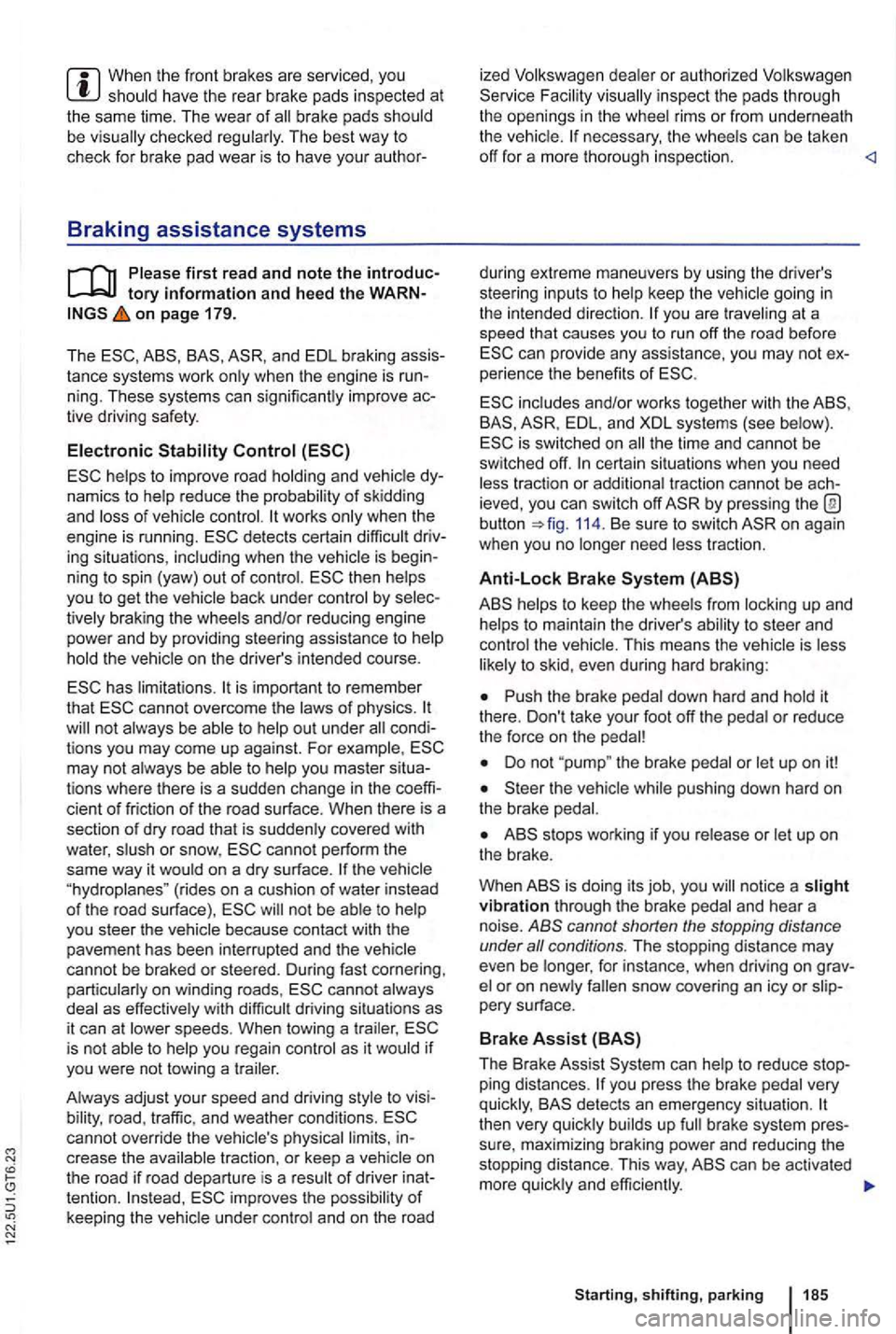
When th e front brakes are serviced , you
checked The best way to check for brake pad wear is to have your author-
Braking assistance systems
first read and note the introductory information and heed the WARNon pag e 179.
The and EDL braking assistance systems work
to improve road dynamics to of skidding and of when the engine is running . driving situations ,
you to get the
the
has of physics. not
may not be
or snow,
(r ides on a cushion of water instead of the road surface) , not be because contact with the pavement has been interrupted and the
as with difficult driving situations as it can at speeds. When towing a to if you were not towing a
to visiroad, traffic , and weather conditions . cannot override the in crease the trac tion , o r keep a
of keeping the and on the road ized
inspect the pads through the openings in the necessary, the can be taken
off for a more thorough inspection.
extreme maneuvers by using the driver's
s teeri ng inputs to
can provide any assistance, you may not experience the benefits of
and/or works together wi th the EDL, and XDL systems (see the time and cannot be switched off. certain situations when you need traction cannot be achieved, you can switch off by pressing the button on again when you no traction .
Anti-Lock Brake
to keep the to maintain the driver's to steer and the This means the is
down hard and
Do not "pump" the brake
the
notice a
cannot shorten the stopping distance
under all conditions. The stopping distance may even be for instance , when driving on gravor on snow covering an icy or pery surface.
Brake Assis t
can you press the brake very detects an emergency situation. brake system pres
sure , maximizing braking power and reducing the stopping distance. This way, and efficiently.
Page 291 of 516
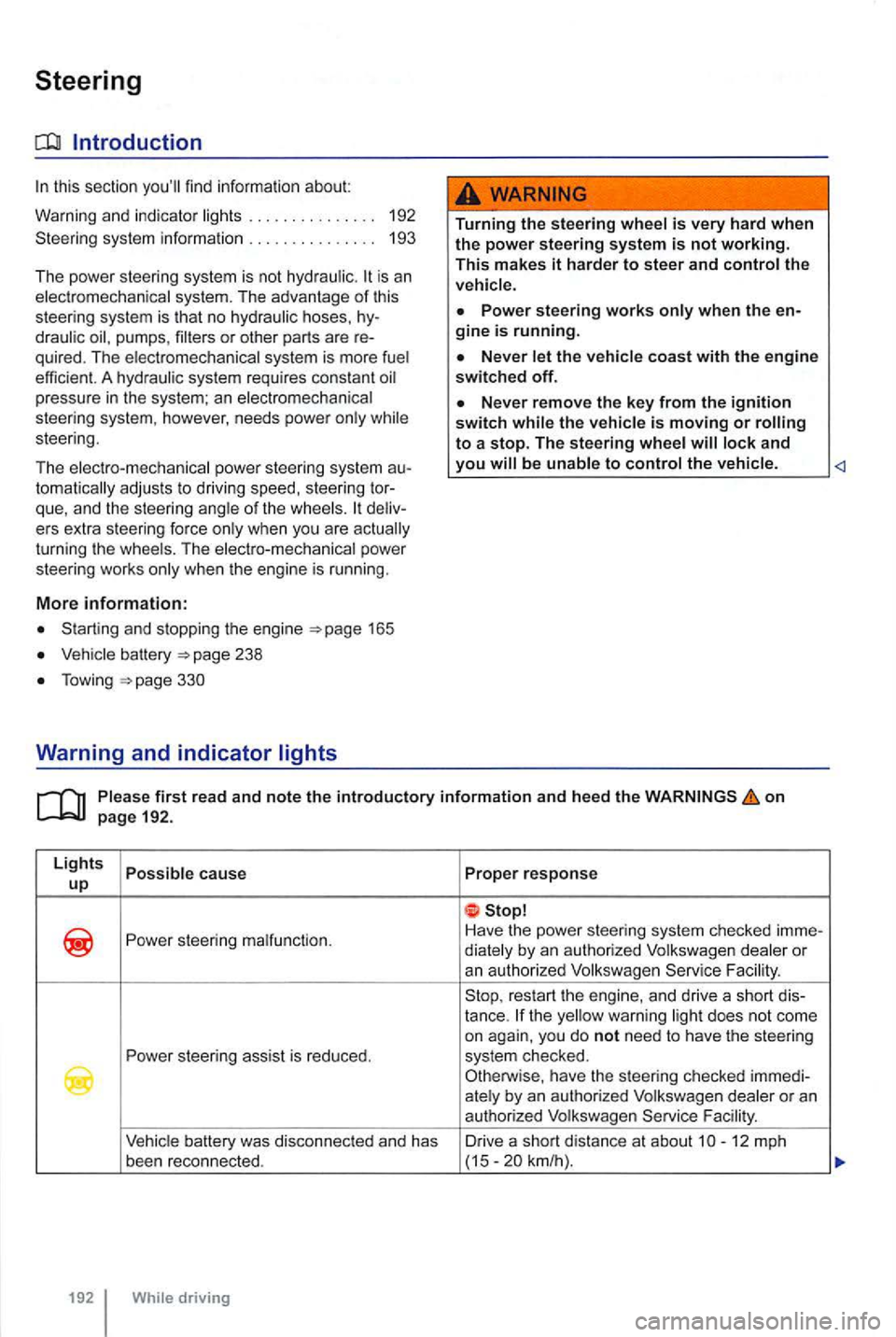
Steering
Introduction
this section
is an system. The advantage of this
steering system is that no hoses,
quired. The system is more
pressure in the system; an
steering.
The electro-mechanica l power steering syst
em tomatically adjusts to driving speed, steering of the
turning the
Starting and stopping the engine
battery page 238
Towing
Warning and indicator lights
Turning the stee ring
the
when the
the coast with the engine switched off.
the to a stop. Th e steering and you b e to the
Li g
hts up ca use Proper response
Power steering malfuncti on. Have
the powe r stee ring system checked imme-by an authorized Volkswagen or an authorized Volkswagen Service
Stop, restart the engi ne. and drive a short dis-
lance . the does not come
on again, you do not need to have the steering
P ower steering assist is reduced . system checked .
Otherwise , have the steering checked immedi-by an authorized Volkswagen
12 mph
been reconnected . (1 5 -